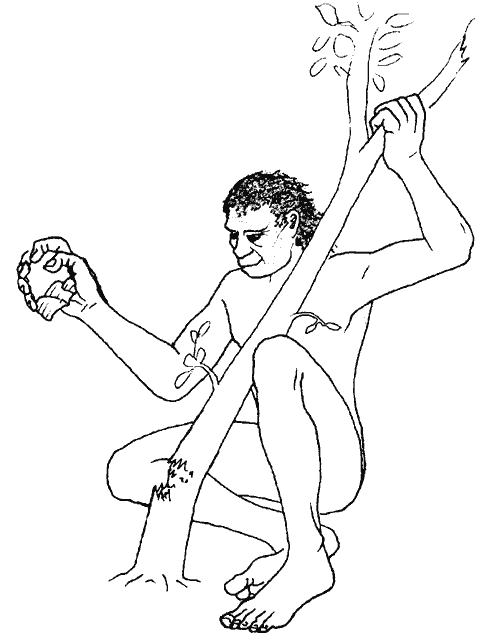|
Oldowan
The Oldowan (or Mode I) was a widespread stone tool archaeological industry during the early Lower Paleolithic spanning the late Pliocene and the first half of the Early Pleistocene. These early tools were simple, usually made by chipping one, or a few, flakes off a stone using another stone. Oldowan tools were used during over a period spanning from 2.9 million years ago up until at least 1.7 million years ago (Ma), by ancient hominins (early humans) across much of Africa. This technological industry was followed by the more sophisticated Acheulean industry (two sites associated with ''Homo erectus'' at Gona in the Afar Region of Ethiopia dating from 1.5 and 1.26 million years ago have both Oldowan and Acheulean tools). The term ''Oldowan'' is taken from the site of Olduvai Gorge in Tanzania, where the first Oldowan stone tools were discovered by the archaeologist Louis Leakey in the 1930s. However, some contemporary archaeologists and palaeoanthropologists prefer to use th ... [...More Info...] [...Related Items...] OR: [Wikipedia] [Google] [Baidu] |
Gona, Ethiopia
Gona is a paleoanthropological research area in Ethiopia's Afar Region. Gona is primarily known for its archaeological sites and discoveries of hominin fossils from the Late Miocene, Early Pliocene and Early Pleistocene. Fossils of ''Ardipithecus'' and ''Homo erectus'' were discovered there''.'' Two of the most significant finds are an '' Ardipithecus ramidus'' postcranial skeleton and an essentially complete ''Homo erectus'' pelvis. Historically, Gona had the oldest documented Oldowan artifact assemblages. Archaeologists have since found older examples of the Oldowan at other sites. Still, Gona's Oldowan assemblages have been essential to the archaeological understanding of the Oldowan. Gona's Acheulean archaeological sites have helped us understand the beginnings of the Acheulean Industry. History Paleoanthropological interest in the locality that would eventually become the Gona Paleoanthropological Research Project area began after a French geologist, Maurice Taieb, under ... [...More Info...] [...Related Items...] OR: [Wikipedia] [Google] [Baidu] |
Stone Tool
Stone tools have been used throughout human history but are most closely associated with prehistoric cultures and in particular those of the Stone Age. Stone tools may be made of either ground stone or knapped stone, the latter fashioned by a craftsman called a flintknapper. Stone has been used to make a wide variety of tools throughout history, including arrowheads, spearheads, hand axes, and querns. Knapped stone tools are nearly ubiquitous in pre-metal-using societies because they are easily manufactured, the tool stone raw material is usually plentiful, and they are easy to transport and sharpen. The study of stone tools is a cornerstone of prehistoric archaeology because they are essentially indestructible and therefore a ubiquitous component of the archaeological record. Ethnoarchaeology is used to further the understanding and cultural implications of stone tool use and manufacture. Knapped stone tools are made from cryptocrystalline materials such as chert, f ... [...More Info...] [...Related Items...] OR: [Wikipedia] [Google] [Baidu] |
Olduvai Gorge
The Olduvai Gorge or Oldupai Gorge in Tanzania is one of the most important paleoanthropology, paleoanthropological localities in the world; the many sites exposed by the gorge have proven invaluable in furthering understanding of early human evolution. A steep-sided ravine in the Great Rift Valley that stretches across East Africa, it is about 48 km long, and is located in the eastern Serengeti Plains within the Ngorongoro Conservation Area in the Olbalbal ward located in Ngorongoro District of Arusha Region, about from Laetoli, another important archaeological locality of early human occupation. The British/Kenyan paleoanthropologist-archeologist team of Mary Leakey, Mary and Louis Leakey established excavation and research programs at Olduvai Gorge that achieved great advances in human knowledge. The site is registered as one of the National Historic Sites of Tanzania. The gorge takes its name from the Maasai language, Maasai word ''oldupai'' which means "the place of the ... [...More Info...] [...Related Items...] OR: [Wikipedia] [Google] [Baidu] |
Homo Habilis
''Homo habilis'' ( 'handy man') is an extinct species of archaic human from the Early Pleistocene of East and South Africa about 2.4 million years ago to 1.65 million years ago ( mya). Upon species description in 1964, ''H. habilis'' was highly contested, with many researchers recommending it be synonymised with ''Australopithecus africanus'', the only other early hominin known at the time, but ''H. habilis'' received more recognition as time went on and more relevant discoveries were made. By the 1980s, ''H. habilis'' was proposed to have been a human ancestor, directly evolving into ''Homo erectus'', which directly led to modern humans. This viewpoint is now debated. Several specimens with insecure species identification were assigned to ''H. habilis'', leading to arguments for splitting, namely into "'' H. rudolfensis''" and "'' H. gautengensis''" of which only the former has received wide support. Like contemporary ''Homo'', ''H. habilis'' brain size generally varied from . ... [...More Info...] [...Related Items...] OR: [Wikipedia] [Google] [Baidu] |
Chopper (archaeology)
Archaeologists define a chopper as a pebble tool with an irregular cutting edge formed through the removal of lithic flake, flakes from one side of a stone. Choppers are crude forms of stone tool and are found in archaeological industry, industries as early as the Lower Palaeolithic from around 2.5 million years ago. These earliest known specimens were found in the Olduvai Gorge in Tanzania by Louis Leakey in the 1930s. The name Oldowan was given to the tools after the site in which they were excavated. These types of tools were used an estimated time range of 2.5 to 1.2 million years ago. Formation To create this tool, one would have to use a hammerstone to chip away flakes on the stone to create a side of the stone with a very sharp edge, allowing for the cutting and hacking of an object. This is a unique type of lithic reduction, as only a single side of the stone is retouched to produce the cutting surface of the stone. The side that does not do the cutting is left unscathed ... [...More Info...] [...Related Items...] OR: [Wikipedia] [Google] [Baidu] |
Acheulean
Acheulean (; also Acheulian and Mode II), from the French after the type site of Saint-Acheul, is an archaeological industry of stone tool manufacture characterized by the distinctive oval and pear-shaped "hand axes" associated with ''Homo erectus'' and derived species such as ''Homo heidelbergensis''. Acheulean tools were produced during the Lower Palaeolithic era across Africa and much of West Asia, South Asia, East Asia and Europe, and are typically found with ''Homo erectus'' remains. It is thought that Acheulean technologies first developed about 2 million years ago, derived from the more primitive Oldowan technology associated with ''Homo habilis''. The Acheulean includes at least the early part of the Middle Paleolithic. Its end is not well defined; if Sangoan (also known as Epi-Acheulean) is included, it may be taken to last until as late as 130,000 years ago. In Europe and Western Asia, early Neanderthals adopted Acheulean technology, transitioning to Mouste ... [...More Info...] [...Related Items...] OR: [Wikipedia] [Google] [Baidu] |
Australopithecus Garhi
''Australopithecus garhi'' is a species of australopithecine from the Bouri Formation in the Afar Region of Ethiopia 2.6–2.5 million years ago (mya) during the Early Pleistocene. The first remains were described in 1999 based on several skeletal elements uncovered in the three years preceding. ''A. garhi'' was originally considered to have been a direct ancestor to ''Homo'' and the human line, but is now thought to have been an offshoot. Like other australopithecines, ''A. garhi'' had a brain volume of ; a jaw which jutted out (prognathism); relatively large molars and premolars; adaptations for both walking on two legs (bipedalism) and grasping while climbing (arboreality); and it is possible that, though unclear if, males were larger than females (exhibited sexual dimorphism). One individual, presumed female based on size, may have been tall. ''A. garhi'' is the first pre-''Homo'' hominin postulated to have manufactured tools—using them in butchering—and may be counted ... [...More Info...] [...Related Items...] OR: [Wikipedia] [Google] [Baidu] |
Homo Ergaster
''Homo ergaster'' is an extinct species or subspecies of archaic humans who lived in Africa in the Early Pleistocene. Whether ''H. ergaster'' constitutes a species of its own or should be subsumed into '' H. erectus'' is an ongoing and unresolved dispute within palaeoanthropology. Proponents of synonymisation typically designate ''H. ergaster'' as "African ''Homo erectus''" or "''Homo erectus ergaster''". The name ''Homo ergaster'' roughly translates to " working man", a reference to the more advanced tools used by the species in comparison to those of their ancestors. The fossil range of ''H. ergaster'' mainly covers the period of 1.7 to 1.4 million years ago, though a broader time range is possible. Though fossils are known from across East and Southern Africa, most ''H. ergaster'' fossils have been found along the shores of Lake Turkana in Kenya. There are later African fossils, some younger than 1 million years ago, that indicate long-term anatomical continuity, ... [...More Info...] [...Related Items...] OR: [Wikipedia] [Google] [Baidu] |
Homo Erectus
''Homo erectus'' ( ) is an extinction, extinct species of Homo, archaic human from the Pleistocene, spanning nearly 2 million years. It is the first human species to evolve a humanlike body plan and human gait, gait, to early expansions of hominins out of Africa, leave Africa and colonize Asia and Europe, and to Control of fire by early humans, wield fire. ''H. erectus'' is the ancestor of later human species, including ''Homo heidelbergensis, H. heidelbergensis'' — the last common ancestor of human, modern humans, Neanderthals, and Denisovans. As such a widely distributed species both geographically and temporally, ''H. erectus'' anatomy varies considerably. Subspecies are sometimes recognized: ''Java Man, H. e. erectus'', ''Peking Man, H. e. pekinensis'', ''Solo Man, H. e. soloensis'', ''Homo ergaster, H. e. ergaster'', ''Dmanisi hominins, H. e. georgicus'', and ''Tautavel Man, H. e. tautavelensis''. The species was first species description, described by Eugène Dubois i ... [...More Info...] [...Related Items...] OR: [Wikipedia] [Google] [Baidu] |
Louis Leakey
Louis Seymour Bazett Leakey (7 August 1903 – 1 October 1972) was a Kenyan-British palaeoanthropologist and archaeologist whose work was important in demonstrating that humans evolved in Africa, particularly through discoveries made at Olduvai Gorge with his wife, fellow palaeoanthropologist Mary Leakey. Having established a programme of palaeoanthropological inquiry in eastern Africa, he also motivated many future generations to continue this scholarly work. Several members of the Leakey family became prominent scholars themselves. Another of Leakey's legacies stems from his role in fostering field research of primates in their natural habitats, which he saw as key to understanding human evolution. He personally focused on three female researchers, Jane Goodall, Dian Fossey, and Birutė Galdikas, calling them " The Trimates." Each went on to become an important scholar in the field of primatology. Leakey also encouraged and supported many other PhD candidates, most notabl ... [...More Info...] [...Related Items...] OR: [Wikipedia] [Google] [Baidu] |
Homo
''Homo'' () is a genus of great ape (family Hominidae) that emerged from the genus ''Australopithecus'' and encompasses only a single extant species, ''Homo sapiens'' (modern humans), along with a number of extinct species (collectively called archaic humans) classified as either ancestral or closely related to modern humans; these include ''Homo erectus'' and ''Homo neanderthalensis''. The oldest member of the genus is ''Homo habilis'', with records of just over 2 million years ago. ''Homo'', together with the genus ''Paranthropus'', is probably most closely related to the species ''Australopithecus africanus'' within ''Australopithecus''.'''' The closest living relatives of ''Homo'' are of the genus ''Pan (genus), Pan'' (chimpanzees and bonobos), with the ancestors of ''Pan'' and ''Homo'' estimated to have diverged around 5.7–11 million years ago during the Late Miocene. ''H. erectus'' appeared about 2 million years ago and spread throughout Africa (deba ... [...More Info...] [...Related Items...] OR: [Wikipedia] [Google] [Baidu] |
Lower Paleolithic
The Lower Paleolithic (or Lower Palaeolithic) is the earliest subdivision of the Paleolithic or Old Stone Age. It spans the time from around 3.3 million years ago when the first evidence for stone tool production and use by hominins appears in the current archaeological record, until around 300,000 years ago, spanning the Oldowan ("mode 1") and Acheulean ("mode 2") lithics industries. In African archaeology, the time period roughly corresponds to the Early Stone Age, the earliest finds dating back to 3.3 million years ago, with Lomekwian stone tool technology, spanning Mode 1 stone tool technology, which begins roughly 2.6 million years ago and ends between 400,000 and 250,000 years ago, with Mode 2 technology. The Middle Paleolithic followed the Lower Paleolithic and recorded the appearance of the more advanced prepared-core tool-making technologies such as the Mousterian. Whether the earliest control of fire by hominins dates to the Lower or to the Middle Paleolithic rem ... [...More Info...] [...Related Items...] OR: [Wikipedia] [Google] [Baidu] |








